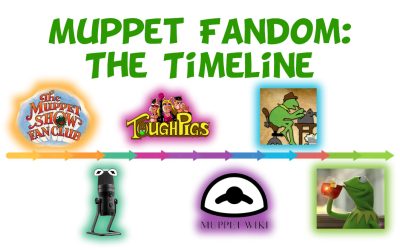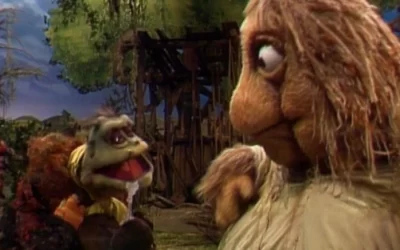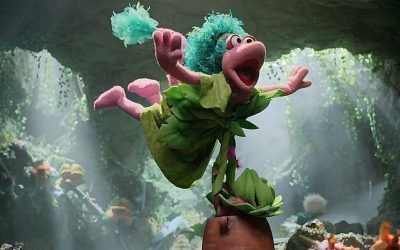John Tartaglia became a Muppeteer when he was just sixteen years old. Since then, he’s played dozens of characters on Sesame Street, as well as starring in the Tony-winning Broadway musical Avenue Q and his own Disney Channel show Johnny and the Sprites, and now he’s the new performer for Gobo Fraggle. Recently, Mr. Tartaglia took some time out from his busy schedule to join us for a Q&A, which we’ll be presenting in two parts. (This is the first part.)
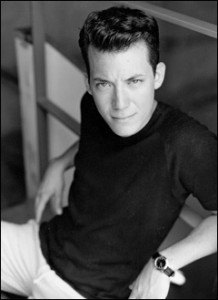
ToughPigs: We have a lot to talk about with you, but the easiest place to start is how you got started with puppetry, and with working with the Muppets.
John Tartaglia: Well, I got started with puppetry because of Fraggle Rock, actually, which is very full circle now. I started watching the show when I was about seven years old, and became obsessed with it, and I wanted to do what they were doing. I started out as a general fan, loving the show and the music and the characters, and then there was that one day where I was like, “Wait, there are people that do this!”
I remember reading the back of my Fraggle Rock album and being like, “Wait, this guy Jerry Nelson does all these characters?” and “Who’s Karen Prell?” and I was suddenly fascinated by these people. So I kind of became obsessed with the puppeteers, and then that led into wanting to do what they do. And I had kind of a knack for it — I could kind of understand movement, because I come from an acting family. So I understood performance, and I realized that it was a great way to do characters, at age seven or eight, like I’d never get to do otherwise.
That led to writing letters to Jim Henson. There’s kind of a long, long story there, but the short of it is, I never got to meet Jim, but when I was twelve or so, I had written letters to Jim right before he passed away, and had almost met him on two different occasions. Very close calls, and they didn’t happen, but when I was fourteen I wrote to Kevin Clash, and he contacted me and said that Jim had said my name to him at one point: “Hey, here’s a bunch of young puppeteers coming up; we should foster them.” I guess I was one of those, and he recognized my name and called, and I started working with the Muppets not too long after that. So it was really kind of a golden, amazing opportunity, and that’s why I always tell people to write letters!
I joined at kind of a transitional time, because the Muppets were still finding where they were going. It was ’94, and it was when there were new movies and other projects coming out without Jim, so there was a lot of new stuff happening. Sesame Street was hiring a lot of new puppeteers.
TP: Muppet Wiki says you were 16 when you started. Is that correct?
JT: My first official day I was 16, yeah.
TP: Was that really intimidating, working with all these veteran puppeteers?
JT: Absolutely. I cried almost every day. You know, you have this “kumbaya” picture in your head of all these Muppeteers as a family, which they are. But like anything, you have all these different personalities, and you have to figure out where you fit in, and where you fit into the family. And I was this young, eager, probably obnoxious puppeteer, who was so excited. So it took me a while to find my own place.
And there’s a hazing period when you join the Muppets that I didn’t know about, so I thought everyone just hated me. Years later, Joey Mazzarino says, “Yeah, we loved you! We were just hazing you!” And I was like, “I didn’t know! I was crying every day!” But to be that young, and to be with Fran Brill and Jerry Nelson and Marty Robinson and all these amazing people that I idolized was really overwhelming.
TP: Do you remember what your first character was?
JT: I did a lot of right hands starting out. My first speaking character was a character called J.J. who was on Sesame Street. He was part of Kingston Livingston’s gang. We only did like three or four episodes with them, but it was actually a big deal because it was me, Alice Dinnean, and Matt Vogel. Matt and I were the new kids. We were both freshly hired. So everyone was like, “Wow, you already have a speaking character!” Again, they only lasted two or three episodes, but it was exciting to have something. I look back at that now — I have video of it — and I’m like, “Oh, man, I’m awful!” I was just so excited to speak that I didn’t think about who these characters were at all.
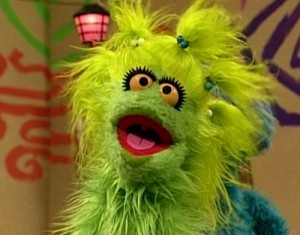 TP: One of your roles was Phoebe from Monster Clubhouse. How did you get cast as a female monster?
TP: One of your roles was Phoebe from Monster Clubhouse. How did you get cast as a female monster?
JT: Totally by accident. Alice Dinnean originated her, and then she had to go do the second or third season of Puzzle Place. Somehow Kevin knew that I could do that voice, and one day he was like, “You’re Phoebe.” I was excited, but I was like, this is such a weird thing to be making my recurring character debut as this female monster. But it was fun. Good old Phoebe, bless her heart.
TP: What happened to Monster Clubhouse?
JT: We just stopped doing it. I guess things go through cycles. We had fun doing them because they were so wacky.
TP: You got to play Ernie on Play With Me Sesame. What was that like, taking the reins of Ernie for a while?
JT: Truly horrifying. It was last-minute, and I’m such a huge fan of Steve’s and Jim’s, and there was all this debate about “Should it be more like Jim’s Ernie, or more like Steve’s Ernie?” and finding what worked.
It’s one of those things I wish I could go back and redo. I was so young, and I think my nervousness came through. But it was really neat, and it was an honor to hold that puppet up, like “Oh my god, what’s happening? I’m living in some alternate universe.” It doesn’t feel like I’m actually doing Ernie, you know.
TP: You’re credited as doing the puppetry only for Hoots in an Elmo music special, Music Works Wonders. How does that work for an entire special?
JT: I think it was one of the first times that Hoots and Elmo had a whole video or a whole segment together. Starting off, I was always a stronger manipulator than I was a voice actor, because I was didn’t have any confidence at that point, and I was young, and it takes a while to become worldly with voices and understand how to control it.
I did a lot of physical stuff, and Kevin knew I was really good at manipulation, and with Hoots, Kevin has a very specific style of puppetry and I think he wanted me to emulate that. I might be wrong, but I think it was all done live, and I think he would throw the voice live and I would do it.
TP: So you’re lip-syncing live to his voice with him also playing Elmo.
JT: Yeah.
TP: That sounds impossible for both of you.
JT: At the time we just had to get it done, and we just kind of did it. But looking back, that is kind of crazy. I’m sure some of it must have been prerecorded, but sometimes when it’s prerecorded and they play it back it’s actually harder because you’re trying to catch the sound, as opposed to when you’re there and you hear the person breathe before they speak. It’s almost like more of a naturalistic rhythm. Kind of like we did with Avenue Q, when Stephanie would throw her voice to Lucy. It’s funny, I had forgotten about that, but I remember thinking that was a big deal, to have this major character that wasn’t really mine but I was doing it for that video.
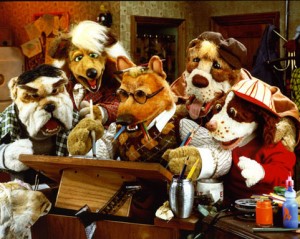 TP: Looking at your credits on the Muppet Wiki, unless we’re missing something, it looks like the only [non-Sesame] Muppet-related work you did was Dog City. Have you never really worked with the Muppets themselves?
TP: Looking at your credits on the Muppet Wiki, unless we’re missing something, it looks like the only [non-Sesame] Muppet-related work you did was Dog City. Have you never really worked with the Muppets themselves?
JT: Not really. I worked on Bear in the Big Blue House and I did do one photo shoot with Miss Piggy, where I held her up, and I want to think that maybe I did some background-y kind of thing, but never on a major special. It’s the one thing I’ve never really done, which I hope to do, now that there’s so much more Muppet stuff out there.
The basics have changed. When I started working in New York with the Muppets, things were starting to move to LA. I didn’t go out to LA when I was 19. That was a big deal, so most of it’s here on Sesame Street. That was the more New York-based stuff.
TP: What did you do on Dog City?
JT: I was a right hand for two episodes. I was David Rudman’s right hand. Chronologically, I think that was the very first thing I did, like two days before Sesame Street. It kind of all happened at once. Joey Mazzarino gave me a hard time because there was a pyro, explosion-y kind of thing that happened in this particular episode, and I was a minor so I couldn’t be on the set. So they had to kick me off the set, and it was like, “Oh, let’s take little Johnny off the set!” and I was, like, crying because I can’t be part of the exciting part. But I think that was the very, very first thing I might have done, in a week or two span.
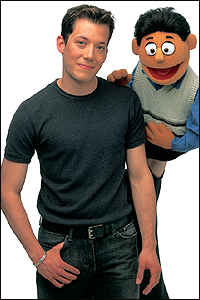 TP: Moving forward a little bit: Avenue Q. What possessed you to parody Sesame Street, which you had been working on for years at that point?
TP: Moving forward a little bit: Avenue Q. What possessed you to parody Sesame Street, which you had been working on for years at that point?
JT: When it started off, it wasn’t actually going to be a theater piece. It was going to be a TV show. Jeff Marx and Bobby Lopez wrote it, and Jeff Marx had been an intern in the music department at Sesame Street. That didn’t go so well, but he knew a few of us who could sing, and had theater aspirations. He knew Stephanie D’Abruzzo and I had done theater and Rick Lyon had a theater background. They went to Rick to build the puppets and get involved, and I believe he recommended me and Stephanie because they wanted a young hero and heroine.
We did a reading of it, and they said, “It’s going to be a TV show, and we want to do an industry reading, so people can come see it and get an idea — and there’s not going to be video cameras, but why don’t you just hold the puppets up like you would on TV, and that way people can pretend.” It was so thrown together, and there were no aspirations for it to be a Broadway show. We just did this reading, and the reaction was unbelievable. With Nicky and Rod, they were Bert-and-Ernie-like, so it was like, how do you do a tribute without just doing the characters? With Rod, I tried to capture the pinched-ness of Bert, and a little bit of the laugh, but really he’s his own little flamboyant thing.
Then the reaction was so huge in the theater that all the producers who were there were like, “This has to be a theater piece.” So it very quickly went away from being a TV show, and then we thought it would be some little off-off-Broadway, underground basement kind of thing, and then of course it became what it did. It was kind of a good training for me that I could bring back to Sesame Street. Because it was the first time where I was given major stuff to do, where I was having to sing all these songs, and come up with characters that really had depth. And then that helped shape some of the character work back on Sesame Street.
TP: Did you ever have any reservations about doing a sort of adult parody of Sesame Street? Was everyone at Sesame cool with it?
JT: That was important to us, because for Stephanie and Rick and I, that’s our home, and our lives. So we very nicely got their blessing. Cheryl and Jane Henson came to see one of the readings, and they said, “Oh, Jim would have loved this.” Because Jim was always pushing the boundaries, but also because Jim always wanted to do theater, but he never quite found a way to do it. So it was kind of nice that we were doing something like what Jim would have maybe wanted to do.
But yeah, we were definitely like, “Is everyone okay with this?” But I think when you see the show, you know it’s a loving tribute to what we all grew up with. And not just Sesame Street, but Electric Company, Mister Rogers, all that kind of feel.
Our thanks to John Tartaglia for his time. Stay tuned to this website for part two of our interview! And click here to be a young, eager, probably obnoxious puppeteer on the Tough Pigs forum!
by Ryan Roe – Ryan@ToughPigs.com

